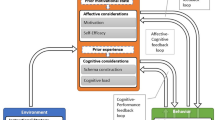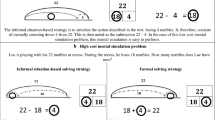Abstract
Schemes are said to underly cognitive processes, including problem solving in Mathematics. An attempt to test the impact of schemes in solving 2-step word-problems was made in an instructional study where two computerized environments were compared. In the S.P.A. (Schemes for Problem Analysis) software, the user works with schemes in order to analyze and solve the problems. When using S.P.A., the solver has to fill in the data in a scheme which is presented graphically. From the scheme the operation is derived in a deterministic manner, and the user (solver) can then calculate the solution. A feedback mechanism follows. In the A.P. (Algebraic Proposer) software the user fills in a table with the data given in the word-problem and then has to find out which operation to use in order to find the solution. The effectiveness of S.P.A. vs. A.P. was empirically examined in an instructional experiment which studied two sixth grade classes during a four month period. The results of the experiment concluded that, in solving easy word problems, both of the two software systems were equally helpful. In harder word-problems, however, those who learned with the S.P.A. experienced more success than those who had learned with A.P. It was also found that S.P.A. was more instrumental in helping low achieving students cope with hard word-problems.
Similar content being viewed by others
References
Anderson, J. A.: 1980,Cognitive Psychology and Its Implication, W. H. Freeman and Company, San Francisco.
Confere: 1992, ‘Theories of learning mathematics’, ICME working group (draft).
Dorfler, W.: 1991, ‘Meaning: Image schemata and protocols’,Proceedings of the PME 15, Assisi, Italy, Vol. 1. pp. 17–32.
Gray, G. B. and Young, R. V.: 1940, ‘The effects of process sequence on the interpretation of two-step problems in arithmetic’,Journal of Educational Research 34, 1.
Greeno, J. G.: 1987, ‘Instructional representations based on research about understanding’, in Schoenfeld, A. H. (ed.),Cognitive Science and Mathematics Education, Erlbaum, Hillsdale, N.J., pp. 61–88.
Hayes, P. T.: 1979, ‘The logic of frames”, in Brachman, R. J. and Levesque, H. J. (eds.),Reading in Knowledge Representation, Morgan Kaufmann Publishers, Inc., California.
Hershkovitz, S., Nesher, P. and Yerushalmi, M.: 1990, ‘Schemes for problem analysis —S.P.A.’, Software program designed by Centre for Educational Technology, Israel.
Kintsch, W.: 1986, ‘Learning from text”,Cognition and Instruction 3, (2), 87–108.
McClelland, J. L. and Rumelhart, O. E. the PDP Research Group: 1987,Parallel Distribution Processing, MIT Press Cambridge, Mass. Press.
Minsky, M.: 1985, ‘A framework for representing knowledge”, in Brachman, R. J. and Levesque, H. J. (eds.),Reading in Knowledge Representation, Morgan Kaufmann Publishers, Inc., California.
Nesher, P. and Katriel, T.: 1977, ‘A semantic analysis of addition and subtraction word problems in arithmetic’,Educational Studies in Mathematics 8, 251–269.
Nesher, P. and Hershkovitz, S.: 1994, ‘The role of schemes in two-step problems: analysis and research findings’,Educational Studies in Mathematics 26, 1–23.
Patterson, J. H. and Smith, M. S.: 1986, ‘The role of computers in higher-order thinking’, in Cudbertson, J. A. and Cunningham, L. L. (eds.),Microcomputer and Education —Eighty-Fifth Yearbook of the National Society for the Study of Education NSSE, Chicago, Illinois.
Riley, M. S., Greeno, J. G. and Heller, J. I.: 1983, ‘Development of children's problem-solving ability in artihmetic‘,The Development of Mathematical Thingking, pp. 153–196.
Reusser, K: 1990, ‘From text to situation to equation: cognitive simulation and understanding and solving mathematical word problems‘,Learning and Instruction 2.2, 477–498.
Schank, R. C. and Abelson, R.: 1977,Scripts, Plans, Goals and Understanding, Lawrence Associates, Hillsdale, New Jersey.
Schwartz, J. L.: 1986a,The Algebraic Proposer, A Mathematical Environment for Analysis, Modelling & Problem Solving.
Schwartz, J. L.: 1986b, ‘Intensive quantity and referent transforming arithmetic operation’, in Hiebert, J. and Behr, M. (eds.),Number Concepts and Operations in the Middle Grades, Vol. 2, NCTM & Erlbaum, pp. 41–53.
Shalin, V. L. and Bree, N. V.: 1985, ‘Structural differences between two-step word problems’, paper presented at the 1987 meeting of the American Educational Research Assocation.
Thompson, P. W.: 1985, ‘Experience, problem solving, and learning mathematics: considerations in developing mathematics curricula’, in Silver, E. A. (ed.),Teaching and Learning Mathematical Problem Solving, Laurence Erlbaum Ass., New Jersey.
Vergnand, G.: 1992, ‘Theories of Learning mathematics’, ICME working group (draft).
Author information
Authors and Affiliations
Rights and permissions
About this article
Cite this article
Hershkovitz, S., Nesher, P. The role of schemes in designing computerized environments. Educ Stud Math 30, 339–366 (1996). https://doi.org/10.1007/BF00570829
Issue Date:
DOI: https://doi.org/10.1007/BF00570829




